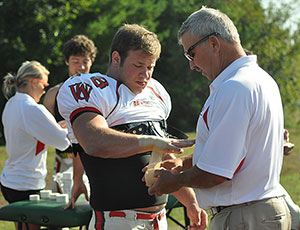
In more than three decades as an athletic trainer at Washington University in St. Louis, Rick Larsen has covered approximately 250 football games and close to 500 basketball games, including both men’s and women’s national championships.
Now entering his 33rd season as a member of the athletic training staff — and his 29th as the Bears’ head athletic trainer — Larsen also has spent time covering professional sports, including stints with the St. Louis football Cardinals and the Arena Football League’s St. Louis Stampede.
We sat down to talk about his work.
You’ve been involved with Washington University Athletics since 1981. Talk about the atmosphere on campus.
Washington University has been a very special place to work, grow and develop a career in athletic training. Establishing a network of orthopedists and healthcare professionals has allowed the Athletic Department to provide quality healthcare for our athletes in an equitable and timely manner.
I wouldn’t enjoy my job as much as I do if it weren’t for the overwhelmingly positive interactions I have each day. I’m proud to work for a university that has enabled me to develop the athletic training program into what it is today.
What part of your job do you enjoy most?

I enjoy interacting with athletes, developing relationships and helping them recover from injuries. Drawing on my own experiences, I’m able to develop treatment and rehabilitation plans that will safely return them to competition.
It is personally satisfying to see an injured athlete, who had lost hope, persevere and then return to the game he or she loves.
I also get satisfaction serving as a mentor to the young professionals working in our program — in sharing knowledge and experiences to assist in their growth and development as athletic trainers.
Some readers may not know that you spent five years as the university’s head baseball coach.
I feel very fortunate to have had the opportunity to help lead the baseball program. When I first joined, we encountered challenges, but with time, commitment and hard work, we were selected to play in the program’s first two NCAA tournaments.
Do you keep in touch with former players?
It is always a pleasure to meet with my former players when they return to campus for reunions, games and W Club functions. The conversation inevitably reverts to memorable moments.
You were quite the baseball player in college, starting three years at shortstop at the University of Wisconsin.
Growing up, I was always involved in sports. I played three sports in high school and it was an honor to be able to continue at the collegiate level. I enjoyed being a part of a team, developing friendships and competing for a Big 10 championship. Some of my best college memories involve participating in baseball.
Did your baseball experience at Wisconsin impact your career choice?
My interest in athletics definitely had an influence on becoming an athletic trainer. And the opportunity to help others was appealing to me.

Larsen celebrating the 2008 NCAA Division III Men’s Basketball National Championship. Photo by Joe Angeles/WUSTL Photo Services.